July 3, 2019
Automation is changing the work processes in many industries in the present age. Automation has been made out to be a job-killer for a long time. As more machines and technologies are being developed that can substitute the labor of workers, automation has been conceptualized as a potential threat to employment. However, automation, in reality, is not a killer of jobs for humans for the simple fact that human intervention is required for optimal functioning of the machines.
Automation is driving the decision makers in many manufacturing industries to upgrade the skills of their workforce so that they can make optimal use of the automation technology. The workforce is undergoing a rapid generational change. The growth of a cohort of the millennials and the retirement of baby boomers is bringing about a corresponding change in the factories. This is evident from the evolution of many factories from the historic pre-automation plants to the smart futuristic factories.
While the journey to progress with automation is overwhelming, it comes with a range of uncertainties and challenges. Manufacturers are increasingly concerned about a shortage of skilled labor. Technology is being developed at a faster pace than the inculcation of the required skills to operate it in the students by the schools. School curriculums don’t prepare the young adults enough for the manufacturing jobs that need the workers to be highly proficient in science and technology subjects.

Tens of thousands of baby boomers retire every single day. On the other hand, manufacturers are dealing with their industry’s undermined image of being outdated and low-tech. At the same time, they have to compete with young and technically skilled young workers.
Generational shifts influence the functionality of factories and the workers’ demographics. This imparts a need for the manufacturing executives to retain as well as upgrade the skills of current employees. While the pressing economic burden and market uncertainties may make the manufacturers think about downsizing, it’s now the priority of most manufacturers.
The smart factory workers need to be technologically savvy and digitally fluent. They should have a sense of the internal functioning of the machines to keep them working all the time. Even the simple process of writing an essay on a laptop can be disrupted if the machine is not maintained. Besides, they also need to know how to analyze the data. The previous manufacturing worker generations simply didn’t need these skills. Likewise, future generations are not completely ready for working in an automated work environment. A confluence of factors is making it difficult for manufacturing companies to locate skilled employees for hire.
Another challenge brought about by automation in the industry is the shortage of funds. As the lower-level jobs are being consumed by automation, manufacturers need more skilled labor that demands more wages and benefits. Since there is a shortage of digitally skilled workers, organizations need to take measures to keep the already existing workforce satisfied so that they can be retained in the company.
The solution of all the challenges mentioned above associated with the automation of the workplace in the manufacturing industry is retaining, retraining, as well as recruitment. Top management should begin the search for trainers within the organization. The older workers may not be technologically savvy, but they have the depth of experience and insight that the new workers can benefit from.

The experienced workers’ advice and supervision are invaluable for the company’s automation. Alongside, top management of the manufacturing companies needs to recruit a workforce that is digitally skilled in the manufacturing processes. Digitally skilled workforce not only helps maintain the automated processes but also enhances them.
Implementation of automated processes helps the manufacturers boost organizational productivity and attain competitive advantage in the industry. While there is a substantial cost associated with incentives for the workers, investing in keeping the workforce motivated has proven useful for many manufacturers in the past. The perceived risks associated with automation can be reduced with simultaneous training of the workers to upgrade their automation skills like process improvement and data analysis.
Top management assumes a very important role in realizing these benefits and training opportunities for the workers. Avoiding the integration of the latest technology and automation of the work processes is not an option these days. Instead, the existing experienced staff needs to be retained and retrained. Alongside, the manufacturers need to emphasize finding workers who are not only highly skilled but also have a propensity of long term stay in the organization. With proper training and strategic recruitment, manufacturers can compete with their high-tech contemporaries.
Scott Ellyson, CEO of East West Manufacturing, brings decades of global manufacturing and supply chain leadership to the conversation. In this episode, he shares practical insights on scaling operations, navigating complexity, and building resilient manufacturing networks in an increasingly connected world.